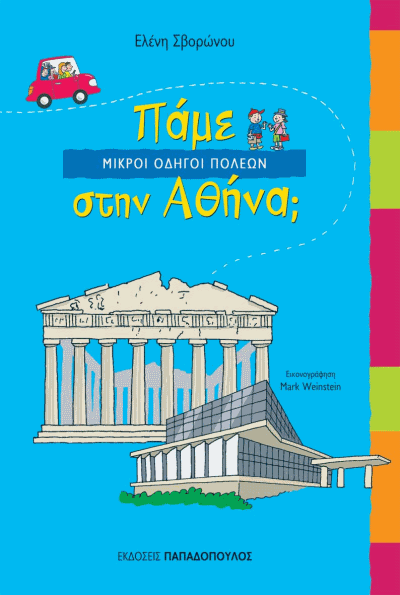Title of the work
Country of the First Edition
Country/countries of popularity
Original Language
First Edition Date
First Edition Details
Eleni Svoronou, Πάμε στην Αθήνα; [Páme stīn Athī́na?], Short City Guides [Μικροί Οδηγοί Πόλεων (Mikroí Odīgoí Póleōn)] (Series). Athens: Papadopoulos Publishing, 2010, 32 pp.
ISBN
Genre
Guidebook
Illustrated works
Instructional and educational works
Target Audience
Children (age 6+)
Cover

Courtesy of the Publisher. Retrieved from epbooks.gr (accessed: July 5, 2022).
Author of the Entry:
Katerina Volioti, University of Roehampton, Katerina.Volioti@roehampton.ac.uk
Peer-reviewer of the Entry:
Susan Deacy, University of Roehampton, s.deacy@roehampton.ac.uk
Elżbieta Olechowska, University of Warsaw, elzbieta.olechowska@gmail.com

Eleni Svoronou
, b. 1965
(Author)
Eleni Svoronou studied Literature in the Aristotle University of Thessaloniki and Heritage Management at the University of Birmingham. Svoronou has been working for WWF in Greece since 1994.
Source:
Profile at the EP Books website (accessed: June 24, 2018).
Bio prepared by Katerina Volioti, University of Roehampton, Katerina.Volioti@roehampton.ac.uk

Mark Weinstein (Illustrator)
Mark Weinstein is an American writer and illustrator who has been living in Greece since 1997.
Source:
Profile at the EP Books website (accessed: April 17, 2018).
Bio prepared by Katerina Volioti, University of Roehampton, Katerina.Volioti@roehampton.ac.uk
Summary
The book’s purpose is to offer young children an overview of Athens’ history and monuments. The author and the illustrator invite children to walk through Athens, to observe sights and architecture, and to think logically and creatively via the book’s exercises.
The front cover depicts the Parthenon and the New Acropolis Museum. These two buildings appear on more pages of the book. Readers will likely form an impression, and with good reason, that this guide is mostly about Athens’ Classical past. Svoronou starts by calling Athens “our old granny,” presumably alluding to grandmothers telling tales of Greek folklore. The illustration here shows a family of four in a car, as in other books in the series. The boy and girl in the backseat are portrayed as explorers, holding a magnifying glass and binoculars. A sketch map of southern Greece, with Athens and its historic centre marked in yellow, strengthens readers’ sense of exploration.
Analysis
This short city guide blends mythological, archaeological, and historical information. Designed especially for children, the guide has an emphasis on adventure and discovery.
There are multiple exercises in the book. Children are asked, for example, to put the names and portraits of Athens’ key historical figures in chronological order. The task here assumes some prior knowledge. The figures are, perhaps unsurprisingly, all-male. They include men from Athens’ Ottoman and Florentine past, which is commendable as children are encouraged to appreciate a multi-ethnic rather than a Graeco-centric past. Theseus is the earliest figure, indicating that mythology, too, is an integral part of history. Svoronou informs us that Theseus was Athens’ mythical king who united all the demes of Attica and built his palace on the Acropolis.
In learning about the Acropolis and its whereabouts, children search for Glafki, a 15-year old girl who went missing one day in Periclean Athens. Having searched for Glafki in archaeological finds and in the two theatres below the Acropolis, children will climb up the Acropolis to look for the girl there. The boy with a magnifying glass in the illustrations captures something from young children’s inquisitive spirit.
Children read about the fight by Poseidon and Athena over the patronage of Athens. The explicit reference to mythology here starts with the phrase "Ένα μύθο θα σας πω…," – "I shall tell you a tale" (my translation). For adult readers, the phrase here recalls a modern popular song by celebrated composer Manos Hatzidakis. The fight between the two gods is presented as a stage performance. Poseidon produced seawater by hitting the rock with his trident. Athena, by contrast, produced an olive tree by shaking her spear. We are told that testimonies to this fight were kept in the Erechtheion. By referring to testimonies, that is, to hard evidence, Svoronou introduces a layer of objectivity, balancing the real with the imaginary in readers’ minds.
The children find Glafki in the new Acropolis Museum. Glafki has become an owl adorning antiquities, such as coins. The transformation from an invented personality to a material object that exists in time and space makes perfect sense since “Glafki” is the word for an owl in Greek. Readers are encouraged, once again, to think logically.
Additional walks through central Athens take children to places in the wider ambit of the Acropolis. Children are always encouraged to go searching for something, such as a mid-20th-century architect’s secret code on the Hill of Philopappos and a representation of Apeliotes (who personified the eastern wind for the ancient Greeks). At Kerameikos and at the Kallimarmaro (the Panathenaic Stadion), children are encouraged to observe and imagine the natural environment, specifically turtles and frogs at the banks of Ilissos at Kerameikos and waterfalls near the Kallimarmaro.
The book closes with suggestions for additional walks and visits, especially to Athenian museums other than those housing archaeological collections. Svoronou is to be praised here for encouraging learning about monuments in their ancient and modern setting, and for making children appreciate how the landscape has changed over time.
Further Reading
Profile at epbooks.gr, published in Greek 29 January 2010 (accessed: July 31, 2018).
Addenda
From a series of five pocket-sized booklets introducing well-known destinations for tourists, namely, Delphi, Crete, Nafplio, Thessaloniki, and Athens.


